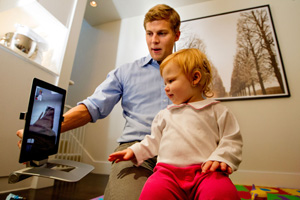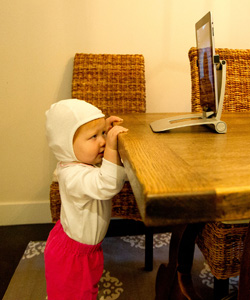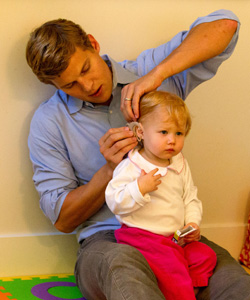December 9, 2013 - By Tracie White

Lucile Ross, 1, and her father, Lyle Ross, say goodbye to teacher Sharon Nutini of the Jean Weingarten Peninsula Oral School for the Deaf, who is onscreen.
One moment, Lucile Ross, sitting in a highchair, is happily chomping on a fistful of Cheerios. The next, she's grabbing her ear, looking up wide-eyed in surprise at the grownups in the tiny room
Lucile, 1, who is severely hearing impaired, obviously just heard something.
"That was beautiful," said her hearing therapist and teacher, Sharon Nutini. "That was the response that we wanted. She immediately reached up." Soft laughter, full of joy and relief, erupted from Lucile's mother and father. The four were crowded together in a small office one day last summer, about a month after a Stanford otolaryngologist had conducted surgery to embed a cochlear implant into each of the girl's ears at Lucile Packard Children's Hospital.
That day, Lucile began her journey to learn how to hear and speak. Her parents, Lizzie and Lyle Ross, captured the moment the implants were activated on video to share with family. But they knew it was just a first step, not an overnight cure, and that their help would be key to their daughter's success.
Lucile is one of about 17 other hearing-impaired toddlers from across Northern California — from Salinas to the Oregon border — to participate in a new "teletherapy" program called BabyTalk, a collaboration between the Stanford School of Medicine's Department of Otolaryngology and the Jean Weingarten Peninsula Oral School for the Deaf in Redwood City.
The program is designed to teach children under the age of 3 how to use their newly implanted cochlear devices to learn how to listen and speak, regardless of where they live or whether their families can pay for the therapy. Every Friday since her cochlear implants were activated, Lucile and her family members have been holding therapy sessions over an iPad from their home in Marin County to learn how to interpret the strange new sounds Lucile is hearing. And she's been making progress.

Lucile who is severely hearing impaired, now has cochlear implants and is receiving listening, language and speech therapy through a program called Babytalk, which is conducted via tablet computer.
"Getting an implant is the easy part," said Nikolas Blevins, MD, the Larry and Sharon Malcolmson Professor and a cochlear implant surgeon. Blevins is part of the BabyTalk team, which also includes a Stanford audiologist and a social worker, in addition to the teachers like Nutini from the Weingarten School.
"The question is, what are you going to do with it once you've got it?" Blevins added. "Without follow-up education and therapy, it's not a useful device. The patient will not develop speech."
For Lucile's mother and father, the decision to outfit their youngest daughter with a cochlear device came after her hearing deteriorated to the point that she was almost completely deaf in both ears. The couple first discovered that she had hearing loss shortly after her birth. A hearing test revealed that Lucile was born with profound loss in one ear and mild loss in the other. Doctors couldn't pinpoint a cause, but the hearing loss wasn't severe enough then to warrant cochlear implants. Instead, she got hearing aids. But by 8 months, her hearing loss had progressed, and at 10 months her parents scheduled surgery.
"We'd heard so many success stories," Lizzie Ross said. "Just knowing that she would have the opportunity to hear and develop speech at a young age — we knew it was the right thing for us."
A cochlear implant is an electronic device. One part includes electrodes that have been surgically implanted in the inner ear; another part, which sits outside the ear, includes a microphone. It can help the profoundly deaf and severely hard of hearing learn to listen and speak, and is particularly successful if implanted prior to the age of 3. The first three years after a child is born are the most critical for the development of speech and language.
The device works by electronically transporting sounds from the microphone, which sits behind the ear, to the inner electrodes, which stimulate the auditory nerves and send sound information to the brain. The device doesn't restore normal hearing; new recipients have described what they "hear" as sounding robotic or like ducks quacking, or just plain weird. But it can give a deaf person a useful representation of sounds and help him or her to understand speech. In order to do that, however, the implant-wearer needs training.

Lyle Ross helps Lucile with her cochlear implant.
This is where the BabyTalk program comes in. BabyTalk sets up virtual classrooms in the childrens' homes in the months following implantation of the cochlear devices so that teachers can meet regularly to train families both on the mechanics of the implants and on how to use them. The training is conducted over video calls on an iPad, which allows face-to-face communication between the teacher and the student and his or her family members. Participation in the program typically lasts until the child turns 3.
"My therapists are passionate about this," said Kathleen Sussman, director of the Weingarten school, whose staff works with the children enrolled in BabyTalk. "They realize the isolation these families feel."
The program includes a one-night stay for the family at the Weingarten school to personally meet the child's therapist and professional team. All services, if not otherwise covered, are provided for free through a grant from a community donor.
"It's all about coaching the parents, about doing the work," said Jan Larky, a Stanford audiologist who is part of the BabyTalk team. "A deaf child who is implanted when they are really young, and who gets really good therapy, you would never know they are deaf."
Fast-forward three months. Lucile was back in a highchair, chomping on Cheerios, this time in her home. Her dad, dressed in his work clothes, had his sleeves rolled up and was talking to Nutini over the iPad. Lucile had made great progress in a short time. She looked up when her dad talked. She babbled frequently, obviously trying to create words to communicate.
And she got upset when dad took the Cheerios away.
"Nah, nah!" she demanded.
"She's been saying 'nah, nah,' a lot," Lyle Ross said. "She seems to be saying 'I want that.'"
"Nah, nah!" Lucile continued.
"That would be fabulous, and really quick," Nutini said. She goes on to give Lyle a string of instructions on how to use Lucile's toys to elicit certain sounds: "sss" for the plastic snake; "mmmm" for the plastic ice cream cone. Lucile turned her head when she heard the door shut.
"My goal is to make therapy a daily living experience," said Nutini, a longtime teacher at the Weingarten school. "For example, how do you use a cooking activity to maximize a child's learning? How do you use playtime?" As for Lucile's progress, she's pleased. The family has obviously been practicing the weekly exercises, and Lucile is quickly gaining ground. Her parents hope her language skills will eventually catch up to those of her 3-year-old sister, Becca, who is not hearing impaired.
"She's giving us signs that she understands us, that she's learning language," Lizzie Ross said. "We think that she's going to catch up quickly. Sharon gives us exercises that we do during the week. We sing songs that elicit certain language, we work on the recognition of animal sounds — the dog barking. There's a lot of repetition, a lot of fun play stuff with her own toys — just what she would normally do on a daily basis.
"We knew it would be a hurdle. But for us, it's been worth every minute of it. We were lucky that the opportunity was out there for her to hear and develop speech at a young age. It's been a pretty amazing experience."
About Stanford Medicine
Stanford Medicine is an integrated academic health system comprising the Stanford School of Medicine and adult and pediatric health care delivery systems. Together, they harness the full potential of biomedicine through collaborative research, education and clinical care for patients. For more information, please visit med.stanford.edu.